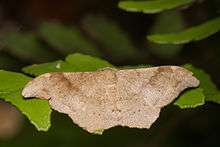Hyposidra talaca
| Black Looper | |
|---|---|
 | |
| Scientific classification | |
| Kingdom: | Animalia |
| Phylum: | Arthropoda |
| Class: | Insecta |
| Order: | Lepidoptera |
| Family: | Geometridae |
| Subfamily: | Ennominae |
| Tribe: | Boarmiini |
| Genus: | Hyposidra |
| Species: | H. talaca |
| Binomial name | |
| Hyposidra talaca (Walker, 1860) | |
| Synonyms | |
| |
The Black looper, (Hyposidra talaca), also known as Black inch worm,[1] is a moth of the family Geometridae. It is found in India to Indochina, Sundaland, Sulawesi, the Philippines, Sri Lanka, the Solomon Islands, Thailand,[2] Taiwan, New Guinea and Australia, where it has been recorded from Queensland. It is a major defoliating pest in tea plantations.[3][4]
Description
The wingspan is about 30 mm. Female with outer margin of hind wings hardly crenulate. Male with outer margin of neither wing excised. Antennae pectinated. Hind wings with outer margin angled at vein 4. Body dark olive fuscous, more or less irrorated and suffused with grey. Both wings faint traces of medial and crenulate postmedial lines. The cilia dark. Fore wings with traces of antemedial line and more or less distinct sub-apical patch in male. Underside with crenulate postmedial line to both wings.[5]
Larva is a looper, with body pinkish olive-green, irrorated with black, and with dark patches on 4th and 6th somites. Later instars are uniform brown.[6]
The larvae feed on the foliage of a wide range of plants, including Anacardium, Bombax, Terminalia, Chromolaena, Gynura, Mikania, Cupressus, Aleurites, Aporusa, Bischofia, Breynia, Glochidion, Hevea, Manihot, Ficus, Morus, Psidium, Polygonum, Rubus, Cinchona, Coffea, Mussaenda, Citrus, Euodia, Schleichera, Theobroma, Perilla frutescens, Camellia and Tectona species.[7][8]
Eggs and caterpillar are largely susceptible for many parasitized hymenopterans, and birds.[9]
Subspecies
- Hyposidra talaca talaca
- Hyposidra talaca schistacea Warren, 1896
- Hyposidra talaca successaria (Walker, 1860)
References
- ↑ "BLACK INCH WORM". Discover Life. Retrieved 8 September 2016.
- ↑ "Hyposidra talaca (Walker, 1860)". geol.utas.edu.au. Retrieved 8 September 2016.
- ↑ "Hyposidra talaca (Walker) - Tocklai" (PDF). Tocklai. Retrieved 8 September 2016.
- ↑ "Hyposidra talaca Walker". ICAR-National Bureau of Agricultural Insect Resources. Retrieved 8 September 2016.
- ↑ Hampson G. F. (1892). "The Fauna Of British India Including Ceylon And Burma Moths Vol-iii". Digital Library of India. p. 558. Retrieved 4 July 2016.
- ↑ "Hyposidra talaca". Butterfly House. Retrieved 8 September 2016.
- ↑ "Host plants of Hyposidra talaca". The Moths of Borneo. Retrieved 8 September 2016.
- ↑ "A successful participatory IPM approach against Hyposidra talaca Wlk., a devastating pest on tea" (PDF). ipmcenters. Retrieved 8 September 2016.
- ↑ "Range expansion of Hyposidra talaca (Geometridae: Lepidoptera), a major pest, to Northeastern Indian tea plantations: Change of weather and anti-predatory behaviour of the pest as possible causes". Research Gate. Retrieved 8 September 2016.
| Wikispecies has information related to: Hyposidra talaca |
| Wikimedia Commons has media related to Hyposidra talaca. |
External links
- Egg-laying pattern of Hyposidra talaca (Lepidoptera: Geometridae) in Northeastern Indian tea plantations: implications for pest management
- Fitness traits of the tea defoliator, Hyposidra talaca (Walker 1860) (Lepidoptera: Geometridae) on natural and artificial diets in relation to gut enzymes and nutritional efficiencies
- Restriction endonuclease fragment analysis of Hyposidra talaca nucleopolyhedrovirus genome
- Morphological diversity, developmental traits and seasonal occurrence of looper pests (Lepidoptera : Geometridae) of tea crop
- In situ mortality of Hyposidra talaca (Geometridae: Lepidoptera) by its nucleopolyhedrovirus and comparison of tea production in untreated and chemical insecticide-treated plots
- Range expansion of Hyposidra talaca (Geometridae: Lepidoptera), a major pest, to Northeastern Indian tea plantations: change of weather and anti-predatory behaviour of the pest as possible causes
- Bio ecology and ecofriendly control of hyposidra talaca walker lepidoptera : geometridae on some multipurpose tree species
- Biology of Hyposidra Talaca
- First record of Hyposidra talaca Walker (Lepidoptera: Geometridae) on Perilla frutescens Linn.